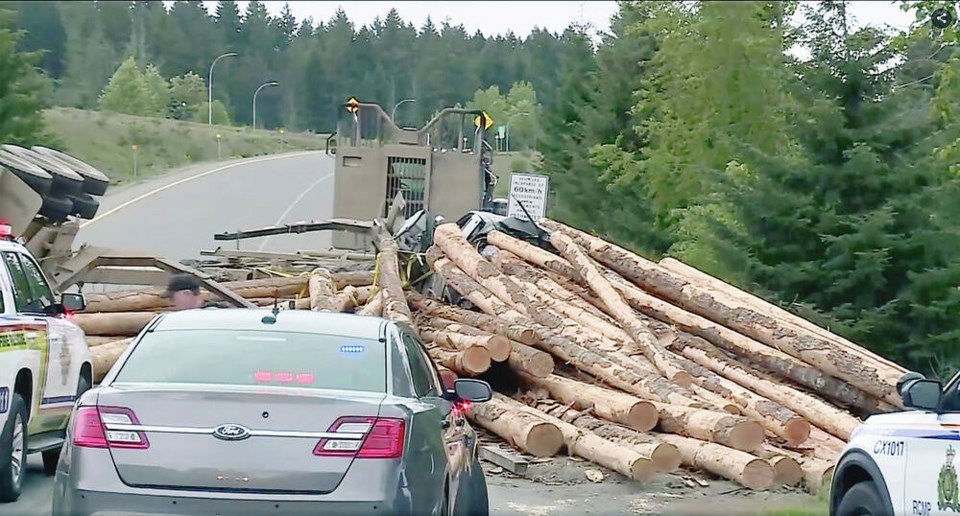On May 24, around 2:30 in the afternoon, Comox Valley RCMP attended an horrific crash on the northbound on-ramp to Highway 19 along the Comox Valley Parkway.
It’s a familiar type of incident for this province actually — a logging truck, stacked high with tons of raw logs, tipped over and spilled its cargo all over the roadway and on the adjacent shoulder.
This time, tragically, it happened right where a man and woman had stopped their pickup truck on the side of the road. The man was killed at the scene and the woman was taken to hospital with injuries.
The Mounties’ traffic experts will get to the bottom of this in time, but in general terms, this scenario is known as an “escaping load,” and it’s a very serious driver safety issue.
We’ve all seen the problem out there — the tiny import car with a mattress planted on its roof — secured via one arm from the driver and one arm from the passenger stuck out of their windows. Or the bouncing trailer or pickup bed pitching out lumber, masonry, ladders, chairs or garden refuse onto the road in front of you.
Sometimes it’s funny to watch, other times not so much.
You might recall a 2021 incident of the Sea to Sky highway where a pickup truck driver “secured” a load of 12-foot boards in the back of his six-foot rear cargo bed. The obviously unbalanced load eventually swung loose from its tie-down straps and out over the right hand side of the truck.
The driver, still truckin’ along at 80 km/h, seemingly didn’t notice the shift until the protruding boards took out two cyclists travelling along the shoulder.
Both riders were hospitalized and the pickup truck driver was fined for driving without reasonable consideration for others as well as having an insecure load.
In the U.S., the problem is of such concern that June 6, aside from the commemoration of the D-Day landings, is also designated as “National Secure Your Load Day.” In 2016 alone, 683 people were killed on U.S. highways as a result of escaping loads.
Our friends in Washington state take this issue so seriously that it’s one of the few highway traffic offences rated as a criminal misdemeanor — meaning that you can be thrown in jail if junk flies off your car onto the roadway.
In sa国际传媒 it’s an offence to operate a vehicle from which your load escapes or have a load secured in a way that improperly affects the way your vehicle normally operates.
Your vehicle has to also be constructed in a manner that safely secures any load you might carry. So the arms out the window method doesn’t cut it.
Fines range from $173 for ordinary vehicles and up to $598 for business and commercial vehicles. Police can impound vehicles where the operator fails to obey their direction to fix a load problem.
There are some simple and basic requirements for moving items in your vehicle.
A load that cannot be contained by the design of your vehicle (ie a canopy on a pickup) should be covered with a tarp, which is then tied down securely to prevent articles from coming loose.
Most vehicles have tie downs that should be used as per your owner’s manual.
Best rule, however: Secure your load as if your own family is driving right behind you.
Glove Box: I received the most amount of email ever about last week’s column on roundabouts. Many people remain confused about what to do, despite the fact that they’ve been with us now for several years and we have over 100 roundabouts in use throughout the province.
There are a few basic rules which make the roundabout work:
- Slow down as you approach.
- Scan ahead, pay attention to your left especially.
- Yield to traffic already in the circle.
- Stay to the right of the centre island within the circle — while always moving counter-clockwise as you go round.
- If there is more than one lane in the roundabout, look for the destination signs and road markers which will put you in the proper lane for your objective.
- In a multi-lane scenario, stay in your lane as you move through the roundabout.
- Signal your intention when exiting.
- Finally, yield to pedestrians in a crosswalk when entering or exiting a roundabout.
If an emergency vehicle is approaching, do not enter the roundabout. If you’re already in it as an emergency vehicle approaches, signal your intention to make your exit then pull over as soon as you’re out of the circle.
Traffic circles, which are found in residential areas and are generally much smaller than a roundabout, are a little different. I’ll talk about those next time.



